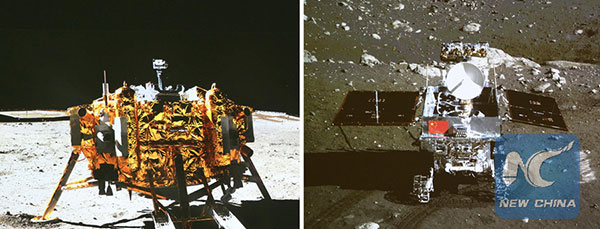 |
|
Screen shows the photos of the Chang'e-3 moon lander (L) and the Yutu moon rover during the mutual-photograph process, at the Beijing Aerospace Control Center in Beijing, Dec 15, 2013. [Photo/Xinnhua] |
The latest data collected by China's first lunar probe Chang'e 3 has confirmed speculation that there is no water on the moon, China Central Television (CCTV)reported on Sunday.
Chang'e 3's optical telescope has discovered that no water exists in an ancient lunar "sea" known as Mare Imbrium ("the Sea of Rains").
When Apollo astronauts walked the lunar surface in 1969 and brought back rock samples, they found none of the water-bearing minerals common on Earth.
According to phys.org, an internet news portal providing the latest news on science, over the past 10 years, however, several developments had reinvigorated the discussion.
In particular, new analyses of volcanic gasses in the sample had inferred the presence of water in the moon's interior.
Meanwhile, several new lunar missions were launched. The ones using neutron spectroscopy to search for water came up with mixed conclusions, but those using infrared spectroscopy seemed to reach unambiguous identification of water on the lunar surface.
"We've measured the amount of water on the lunar surface and above, but only found the lowest quantities so far, which is in line with the expectations of the experts on the formation of the moon,” Wen Jianyan, a researcher from the Chinese Academy of Sciences, said.
China's lunar probe Chang'e-3 - named after the goddess of the moon in Chinese mythology - with the country's first moon rover onboard, successfully landed on the moon on December 14, 2013, marking the first time that China has sent a spacecraft to soft-land on the surface of an extraterrestrial body.
Chang'e 3 has entered its 33rd dormancy period on July 28, a record for the longest work time for an active lunar probe, according to the State Administration of Science, Technology and Industry for National Defense, which is in charge of China's space programs.
Chang'e-3 includes a lander and a moon rover called "Yutu" (Jade Rabbit). Yutu's tasks include surveying the moon's geological structure and surface substances and looking for natural resources.
The Chang'e 3 mission has provided scientists with valuable details about the lunar surface.
Seven terabytes of data collected by Chang'e 3, including pictures and videos, has been shared with thousands of Chinese scientific institutions and universities for laboratory analysis.
Chang'e 3 made the first-ever geological map of the moon with lunar penetrating radar, and also discovered a new type of rock - the lunar basalt, providing an insight into the evolution of the moon and the basis to explore its resources.
Equipped with the world's first extreme ultraviolet imager, Chang'e 3 has been able to study changes in the plasma sphere to monitor solar storms that could disrupt telecommunications on earth.
China will continue its rapid ascent in space science in the next couple of years. The country is planning to send another probe to the moon - the Chang'e 5 robotic lunar sample return mission - which is due to be launched next year.
It also plans to launch Chang'e-4, which is similar to the Chang'e-3 but can carry a bigger payload to land the first probe on the dark side of the moon in 2018.